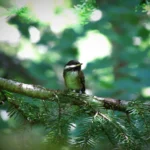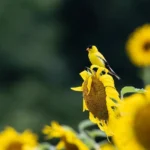Florida, known for its lush landscapes and vibrant ecosystems, is home to a diverse range of bird species. Among these, blue birds hold a special charm, captivating bird watchers and nature enthusiasts alike with their striking hues. This article explores the various types of blue birds in Florida, their habitats, behaviors, and identifying features. From the Eastern Bluebird to the elusive Florida Scrub-Jay, let’s dive into the world of these feathered marvels.
Table of Contents
Types of Blue Birds in Florida
1. Eastern Bluebird (Sialia sialis):
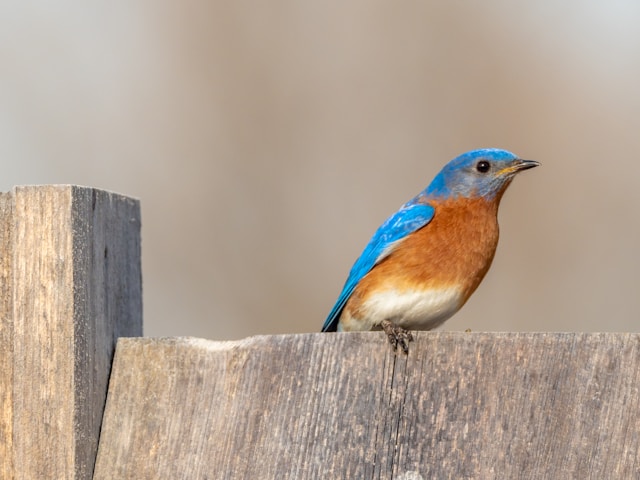
Appearance:
- Males: Vivid blue plumage on the back, rusty red chest, and white underbelly.
- Females: Softer blue tones with more grayish-brown on the back.
Habitat:
- Open fields, meadows, and suburban areas with scattered trees.
- Often found perched on fences or power lines.
Behavior:
- Eastern Bluebirds are cavity nesters, often using tree holes or birdhouses.
- Diet consists of insects, berries, and small fruits.
Fun Fact:
Known for their melodic song, Eastern Bluebirds symbolize happiness and renewal.

2. Florida Scrub-Jay (Aphelocoma coerulescens)

Appearance:
- Entirely blue body with a lighter grayish-white chest and belly.
- Distinctive lack of a crest compared to other jays.
Habitat:
- Endemic to Florida, thriving in scrubby flatwoods and sandy soils.
- Prefers habitats with scrub oaks and palmettos.
Behavior:
- Highly intelligent and social, often forming family groups.
- Known to cache food for later use, such as acorns and small insects.
Conservation Status:
Listed as threatened due to habitat loss and fragmentation.
3.Blue Jay (Cyanocitta cristata)

The Blue Jay is a bold and beautiful bird that brightens Florida’s landscapes. With dazzling blue feathers, a white face, and black accents, including a striking crest, it’s a true showstopper.
Habitat and Adaptability
These adaptable birds thrive in forests, parks, and even suburban gardens, making them a familiar sight across the state.
Unique Behaviors and Vocal Mimicry
Known for their loud calls and mischievous mimicry of hawk sounds, Blue Jays are as entertaining as they are resourceful.
A Versatile Diet
Their diet includes seeds, nuts, insects, and occasionally small vertebrates.
Environmental Contributions
Blue Jays also help the environment by burying acorns, inadvertently planting oak trees.
A Favorite Among Birdwatchers
Intelligent, colorful, and full of character, they’re a favorite among birdwatchers and nature enthusiasts alike!
4. Indigo Bunting (Passerina cyanea)

The Indigo Bunting is a dazzling visitor to Florida, bringing vibrant beauty to the landscape. During the breeding season, males shine with iridescent blue plumage, while females keep it subtle with brown feathers accented by hints of blue.
Preferred Habitats
These birds thrive in open woodlands, shrublands, and farmland edges, often stopping in Florida during their winter migration.
Cheerful Songs and Performances
Known for their cheerful and intricate songs, Indigo Buntings are natural performers that delight bird enthusiasts with their melodic tunes.
Versatile Feeding Habits
Their diet includes seeds, berries, and small insects, showcasing their adaptability as versatile feeders.
A Magical Addition to Birdwatching
With their stunning appearance and captivating songs, Indigo Buntings add a touch of magic to Florida’s birdwatching experiences.
5. Tree Swallow (Tachycineta bicolor)

The Tree Swallow is a sleek, acrobatic bird that graces Florida’s skies with its metallic blue-green back and crisp white underbelly.
Preferred Habitats
These agile flyers are often found near open areas close to water, such as lakes, marshes, and wetlands.
Masterful Aerial Hunters
Tree Swallows are aerial insectivores, skillfully catching their prey mid-flight with unmatched precision.
Nesting and Social Behavior
They nest in tree cavities or birdhouses, often forming colonies in ideal locations.
Mesmerizing Migration Flocks
During migration, Tree Swallows gather in massive, mesmerizing flocks, creating a breathtaking spectacle.
A Joy to Observe
Their graceful flight and shiny plumage make them a joy to watch. Whether gliding over water or perched in the sun, Tree Swallows bring energy and elegance to Florida’s landscapes.n the sun, Tree Swallows bring energy and elegance to Florida’s landscapes.
6. Barn Swallow (Hirundo rustica)

The Barn Swallow is a charming and agile bird, easily recognized by its deep blue back, reddish-orange throat, and long, forked tail.
Habitat and Nesting Preferences
These migratory birds grace Florida’s open fields, farmlands, and areas near water, often building their cup-shaped mud nests on structures like barns, bridges, and even houses.
Masterful Flyers and Insect Hunters
Known for their extraordinary flying skills, Barn Swallows swoop and dart gracefully as they hunt flying insects, their primary diet.
Social and Vocal Nature
Social and vocal, they are often seen in small groups, chattering as they work and interact.
Vibrant Addition to Florida’s Landscape
With their distinctive appearance and lively behavior, Barn Swallows add vibrancy and a touch of rural charm to Florida’s diverse bird population.
7. Painted Bunting (Passerina ciris)
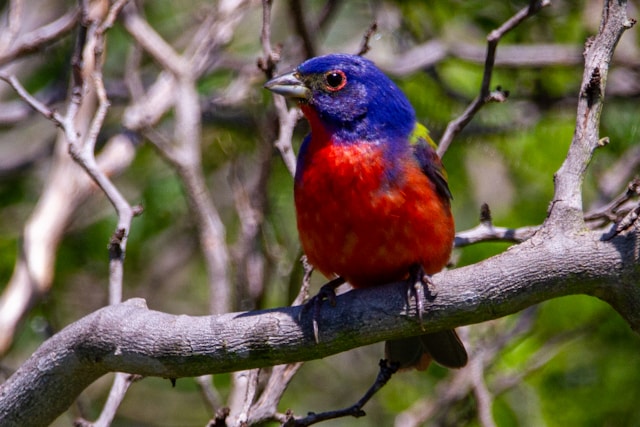
The Painted Bunting is a breathtaking bird, often considered one of North America’s most beautiful. Males are a living rainbow, with vibrant blue heads, greenbacks, and red underparts, while females and juveniles display a subtle olive green, ideal for blending into foliage.
Preferred Habitats
These shy birds thrive in dense shrublands, coastal hammocks, and overgrown fields, frequently seen in Florida during the winter months.
Foraging Habits
Painted Buntings forage close to the ground, feeding on seeds, berries, and insects, showcasing their adaptable diet.
A Hidden Treasure
Despite their secretive nature, spotting a Painted Bunting feels like uncovering a hidden gem, making them a favorite among birdwatchers exploring Florida’s lush landscapes.
8. Cerulean Warbler (Setophaga cerulea)

The Cerulean Warbler is a delicate, sky-colored gem that graces Florida during migration in spring and fall. Males flaunt brilliant sky-blue upperparts with white underbellies accented by black streaks, while females showcase softer greenish-blue tones. These small, active birds thrive in tall deciduous forests, often near rivers and wetlands, where they forage in the treetops for insects. Despite their vibrant beauty, Cerulean Warblers are becoming increasingly rare due to habitat loss. Their cheerful, rapid songs bring a touch of joy to birdwatchers lucky enough to spot them. A fleeting but magical sight in Florida’s birding calendar, they remind us of nature’s delicate wonders.
9. Northern Parula (Setophaga Americana)

The Northern Parula is a small but striking warbler that brightens Florida’s forests during the breeding season. Its blue-gray back, bright yellow chest, and touch of reddish banding make it a standout despite its tiny size.
Preferred Habitats
This bird is commonly found in forested wetlands and hammocks adorned with Spanish moss, flitting through the foliage in search of food.
Feeding and Foraging
The Northern Parula feeds primarily on insects and spiders, actively searching through leaves and branches with boundless energy.
Sweet Songs and Active Charm
Known for their sweet, buzzy songs, these warblers are a delight for birdwatchers. While they may be hard to spot, their lively movements and charming demeanor make them unforgettable.
Adding Life to Florida’s Landscapes
Their energy and beauty bring life to Florida’s lush, moss-draped landscapes, making the Northern Parula a cherished sight in the region.
10. Belted Kingfisher (Megaceryle alcyon)

The Belted Kingfisher is a striking bird with blue-gray plumage, a spiky crest, and a white collar. Females add a distinctive touch with a rust-colored band across their chest, making them stand out even more.
Habitat and Hunting Grounds
These birds are commonly found near rivers, lakes, and coastal waters throughout Florida, where they thrive in watery habitats.
Skilled Hunters
Belted Kingfishers are expert fishers, often perched above water before diving headfirst to catch their prey with precision.
Loud and Unmistakable Calls
Known for their loud, rattling calls, these birds are hard to miss as they patrol their territories along the water.
Unique Nesting Habits
They dig burrows into sandy banks to nest, showcasing a remarkable adaptation to their environment.
Adding Drama to Florida’s Waterways
With their bold appearance, dramatic hunting style, and unmistakable calls, Belted Kingfishers bring excitement and personality to Florida’s waterways.
11. Prothonotary Warbler (Protonotaria citrea)

The Prothonotary Warbler, often called the “swamp canary,” is a dazzling bird with a bright yellow chest and belly that contrasts beautifully with its blue-gray back.
Preferred Wetland Habitats
These birds thrive in swampy forests, mangroves, and other wetland areas, frequently nesting in tree cavities or bird boxes close to water.
Melodic Songs in the Marshes
Known for their sweet and melodic songs, Prothonotary Warblers add a musical charm to Florida’s marshes as they forage.
Diet and Foraging Habits
They primarily feed on insects, snails, and spiders, making them key players in wetland ecosystems.
A Name Reflecting Beauty
Their name is inspired by the vivid robes of Catholic clerks, a nod to their dazzling and regal plumage.
A Treat for Birdwatchers
Spotting this lively warbler is a true delight for anyone exploring Florida’s rich and diverse ecosystems.
12. Blue Grosbeak (Passerina caerulea)
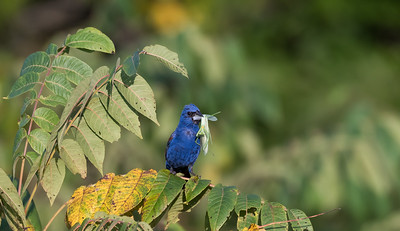
The Blue Grosbeak is a stunning songbird that brings vivid color to Florida’s birding scene. Males boast deep, vivid blue plumage with striking chestnut wing bars, while females exhibit a subtle charm with brownish feathers accented by blue tinges.
Habitats and Migration
These birds thrive in shrubby areas, forest edges, and farmland. Florida often serves as a stopover for them during their winter migration.
Powerful Beaks and Varied Diet
Equipped with powerful beaks, Blue Grosbeaks excel at cracking seeds but also enjoy insects and berries, showcasing their dietary versatility.
Melodious Songs
During the breeding season, their sweet, melodious songs fill the air, delighting bird enthusiasts with their rich and vibrant tunes.
A Standout Among Florida’s Birds
With their dazzling colors and enchanting songs, the Blue Grosbeak is a standout among Florida’s diverse avian residents.
13. Little Blue Heron (Egretta caerulea)

The Little Blue Heron is a graceful and elegant bird that enhances Florida’s wetlands with its subtle beauty. Adults feature slate-blue plumage with a purplish-maroon head, while juveniles start entirely white, transitioning gradually to blue as they mature.
Preferred Habitats
This heron thrives in marshes, estuaries, and mangroves, favoring shallow waters for its foraging activities.
Stealthy Hunters
With deliberate, measured movements, Little Blue Herons stalk fish, amphibians, and other small prey, showcasing their skill as precise hunters.
Serene Foraging Behavior
Often foraging alongside other wading birds, they bring a sense of calm and serenity to Florida’s watery landscapes.
A Blend of Transformation and Elegance
The contrast between the youthful white plumage and the mature blue creates a fascinating transformation. Spotting a Little Blue Heron feels like witnessing art in motion, making it a captivating highlight of Florida’s diverse avian wildlife.
14. Purple Martin (Progne subis)

The Purple Martin is a social and graceful bird that brings energy to Florida’s skies during the breeding season. Males shine with dark, iridescent blue-black feathers, while females display a softer gray-blue with lighter underparts.
Preferred Habitats
These aerial acrobats thrive in open areas near water, often nesting in specially designed martin houses provided by bird enthusiasts.
Agile Flight and Feeding Habits
Known for their impressive flight skills, Purple Martins feed on flying insects, performing agile maneuvers to catch their prey mid-flight.
A Tradition of Nesting
Historically, Native Americans encouraged Purple Martins to nest in gourds, a tradition that continues today with modern birdhouses.
Lively and Charming Addition to Florida’s Birdlife
Their melodious calls and colony lifestyle make them a lively, charming addition to Florida’s diverse bird population, captivating birdwatchers and nature lovers alike.
Conclusion:
Florida’s diverse ecosystems are a haven for bird enthusiasts, offering an array of blue-feathered marvels that captivate with their beauty, behaviors, and songs. From the charming Eastern Bluebird and the rare Florida Scrub-Jay to the dazzling Painted Bunting and the elegant Little Blue Heron, each species tells a unique story of adaptation and survival. Whether soaring through open skies, darting through dense shrublands, or gracing wetlands, these blue birds enrich Florida’s landscapes with their presence.
Observing these avian wonders not only highlights the beauty of Florida’s natural world but also reminds us of the importance of conservation. The threats facing birds like the Florida Scrub-Jay and Cerulean Warbler underline the need to protect their habitats and ensure their survival for future generations. Birdwatching in Florida becomes not just a hobby but a celebration of the state’s incredible biodiversity.

Welcome to World Birds Life, where the wonder of birds takes center stage. My name is Lexi, and I’m passionate about helping you discover the beauty and joy that birds bring into our lives.




